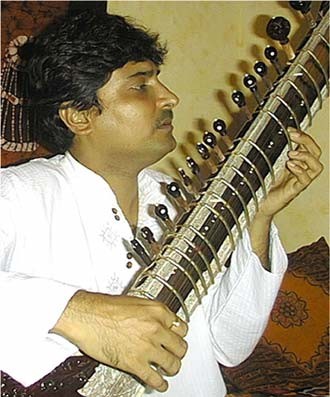|
Local Indian music enthusiast takes his first modest shot at concert promotion You can see the look of deference in Rick Henderson's eyes whenever he speaks about Indian music. That's because his teacher is in the room.Henderson, a local raga enthusiast and longtime player of the sarode, is playing host at his Northeast Side home to his musical guru, Aashish Khan - widely recognized as the world's greatest sarode (a lute-like, 25-stringed instrument) virtuoso - and Khan's adolescent nephew, Sahir. The Indian classical tradition is built on consummate dedication, discipline, and patience, rare traits in this era of instant gratification. Khan is part of an incomparable Indian music dynasty. His grandfather, Allaudin (who lived to be 110) was a musical master who counted a young Ravi Shankar among his disciples, while his father, Akbar Ali Khan, performed in New York in 1955 and came to be known as the "Bach of India." Khan sits barefoot in Henderson's living room. He has white hair, and the calm, humble manner befitting his title as an Ustad (or master musician). As a way of illustrating the kind of long-term diligence required by Indian classical music, he tells the story of the day his father was being honored as an Ustad. "My grandfather said, 'He doesn't even know how to tune his instrument!'" Khan lets out a hearty laugh, but he quickly turns serious and explains that his grandfather purposely denigrated his own son's musicianship, not out of cruelty, but because he didn't want him to become self-satisfied and stop applying himself. So it's easy to understand why Henderson, 51, is a bit sheepish about the fact that he studied the sarode for a mere seven years at the Khans' music school in Marin County, California. A self-described Army brat introduced to Indian music by a sitar player he met in Nepal, Henderson learned the sarode in large ensemble classes with Akbar Ali Khan, recalling that "once in a while, Aashish would visit and waste a few hours of his time with intermediate sarode students."
Henderson was energized when he met another local Aashish disciple, Amie Maciszewski, and he rededicated himself to his study of the sarode. He's found session work in California, and occasionally performs at his place of worship, the First Unitarian Universalist Church. Now, he's taking the bold step of promoting his first Indian concert in San Antonio, an August 21 performance at First Unitarian by sitarist Indrajit Banerjee and Gourisankar Karmakar. "Part of it is totally selfish," Henderson concedes of his leap into small-scale concert promotion. "I love it, I enjoy it so much, why should I have to drive to Austin when I can bring a concert to my church?" Banerjee and Karmakar are considered "young artists," meaning that they're both fortyish. In pop-music terms, this would make them elder statesmen, but traditional Indian masters, if they reach the requisite level of accomplishment, don't begin to tour the world and play major concerts until they are between 35 and 40. Khan recalls that he began taking lessons at about the age of 4, but was not allowed to give his first solo performance until he was 25. As Henderson says, "It takes so long to get it correct." Banerjee was a child prodigy who studied under highly regarded Ravi Shankar disciple Kartick Kurnar. His playing is gentle and understated, with a melodicism that should make him accessible to Western ears. "They're good artists," Khan says of Banerjee and Karmakar. "They're young, and they're related to this tradition of music. Indrajit tries to do something of his own style. A lot of young musicians today, they just try to listen to somebody's CD. They'll learn a little bit and start copying someone else." Khan says he and his family are struggling to maintain their musical tradition, but they're fighting against a powerful pop-culture wave that includes the assembly-line trashiness of India's Bollywood movie machine.
Henderson notes that in the local Indian community, many people are more familiar with jazz than with ragas. Like Khan, he recognizes that Indian classical music demands a consuming dedication rare in the 21st century, but he's determined to make whatever contribution he can to its preservation. "The thing about this music, is that it is an oral tradition," Henderson says. "The only way to learn it is to sit with your teacher. You have to hear your teacher, you have to see your teacher, you have to be with your teacher. And there's no time anymore in Indian society. Plus, there are only so many traditional families that are available, and it only takes a couple of missed generations for it to be lost." •
|


